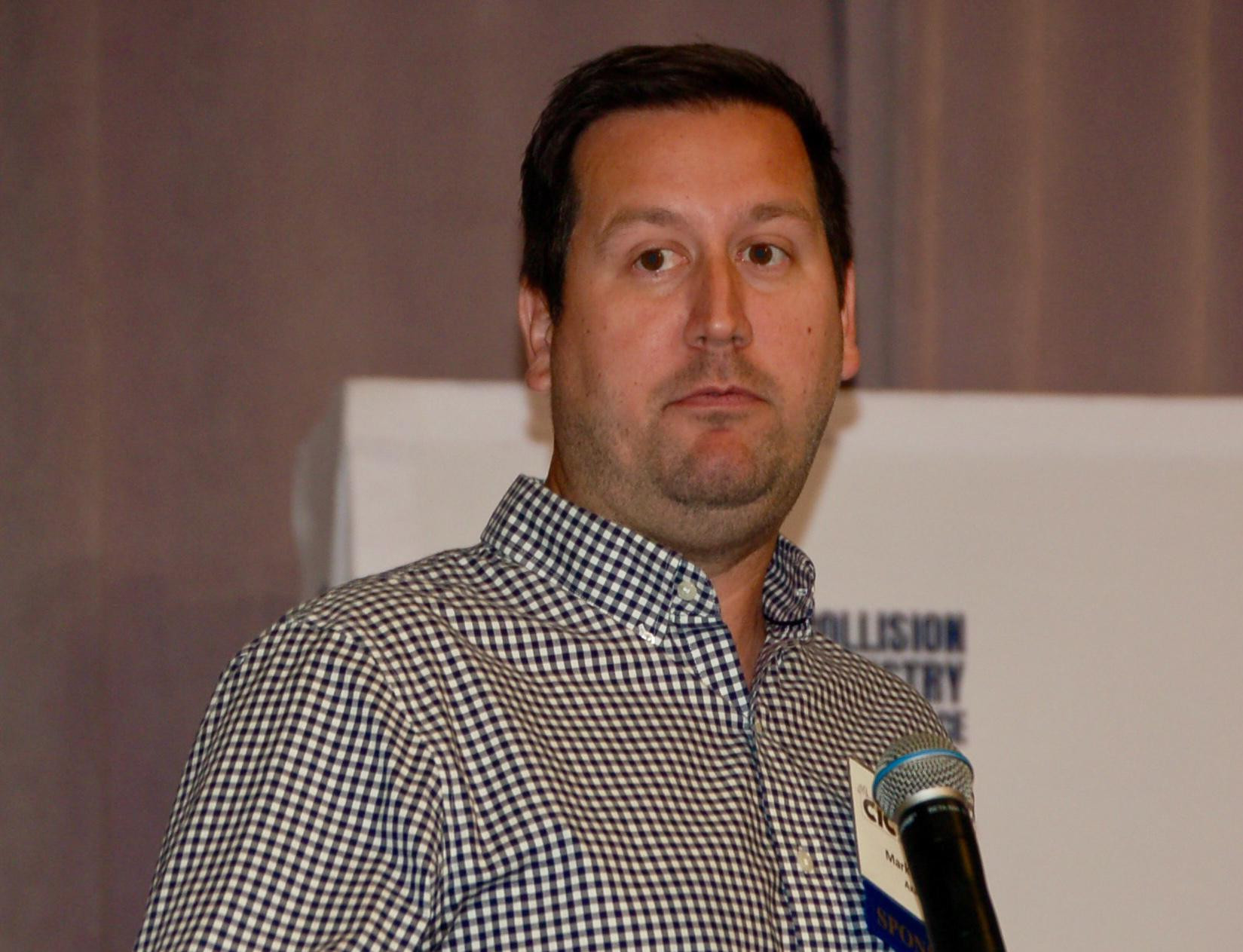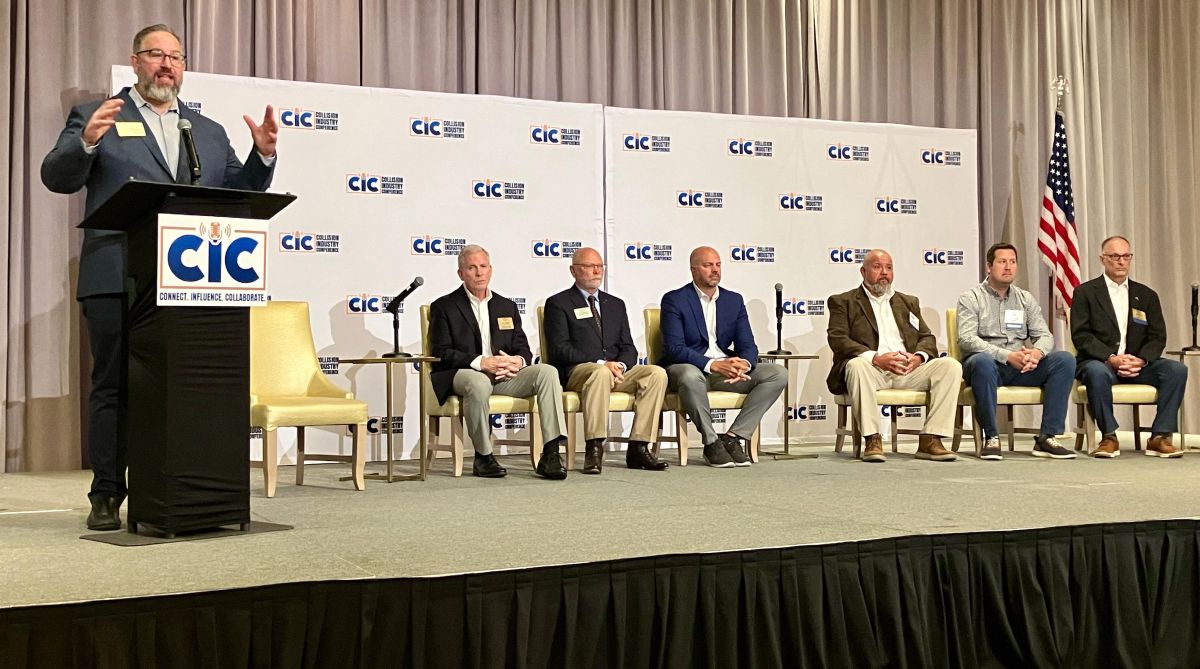While body shops, insurance companies and even the estimating system providers aren’t all seeing eye to eye on the issue of blending for color match, a recent panel discussion offered one point of agreement: the blending process is not the same now as it was decades ago when the prior formula for establishing blend times was developed.
“It does make you realize that things have changed,” Michael Lastuka of State Farm said at this summer’s Collision Industry Conference (CIC) of recent paint company training on blending his company has sent staff to, which he called “enlightening.”
The CIC Parts and Materials Committee hosted the panel discussion on the topic about a year after CCC Intelligent Solutions announced it was giving users more flexibility to determine blend times and eliminating “50% of full refinish time” formula. Audatex made a similar change some months later. Mitchell has not changed either its default nor P-page guidance relative to the 50% blend formula, but does give users the ability to adjust the percentage used.
 Mark Jahnke said blending time can vary based on the size and location of the panel, and even the age of the vehicle.
Mark Jahnke said blending time can vary based on the size and location of the panel, and even the age of the vehicle.
Part of what triggered estimating companies to reexamine the blend formula was a 2022 study conducted by the Society of Collision Repair Specialists (SCRS) that the association believes demonstrated that the blending process takes more time than a full panel refinish, rather than less.
During the panel discussion at CIC, several paint company representatives discussed things that have made blending more complex and variable today than in the past, including the wider variety of vehicle finishes.
“Not that many years ago, we only had about 42 to 46 toners on a mixing machine,” said Ryan Brown, a technical manager for AkzoNobel. “You really only had a range of some solid toners, a couple metallic toners, and at one point there was only one pearl on a mixing machine. We started out with just a white pearl. As the years went by, we added a couple more.
"And then in the 1990s, we started expanding into having a couple more different effects on mixing banks," Brown continued. "The introduction of some different silver dollar type of aluminums, some different things started making colors more complex. But we really never adjusted anything [related to blending] from that time. Each of these things made refinishing a car slightly more difficult. And we’ve only added to that over time.”
Mixing machines today, he said, often include 90 or 100 toners or more.
“On any standard mixing machine from any manufacturer, you’re going to have a range of glass flakes, color-shifting pigments, a lot more highly chromatic, solid toner pigments that we didn’t have before,” Brown said. “We’re now dealing with nano translucent pigments to get more chromatic colors, more transparency, get that kind of candy-looking effect. It greatly changes how we prepare the car, how we spray them, how we apply them. And it adds more time to the operations as well.”
More than Just Change in Materials
Mark Jahnke, a technical coordinator for Axalta Coating Systems, said there’s more that contributes to variation in the time required to blend than just changes to refinish materials.
“The panel location and size of it plays a big factor in the blend,” Jahnke said. “Also the shape of the vehicle. Does it have a lot of body lines, style lines, shaving in the vehicle, or is it a big flat panel with less contours that might prove to be a difficult blend? You might need to use a little bit more space or room.
"The location of the repair: If the repair is located eye line or higher, it generally becomes more visible," Jahnke continued. "Something down lower you can kind of shade and trick and work your way around a blend in a smaller area than you may need up higher on a vehicle. We’re seeing smaller and smaller cars. A bedside on an F-150 is a pretty big area for a blend versus a small quarter panel on a Mazda 3 or a Mazda 6 that’s only a foot-and-a-half or two feet long and makes for a really challenging blend to keep within the panel.”
The age of a vehicle also can impact blending, Jahnke said.
“The average age of vehicles in the U.S. now is 12.6 years, so for every new vehicle coming off the line, there’s a car that’s about 24 or 25 years old still on the road,” he said. “Coatings age over time. A car in Florida is going to have a different degradation of that finish versus a car in the Pacific Northwest. Each is going to have a specific characteristic on that coating that needs to be addressed prior to the blend operation. A lot of times we need to restore that condition to OEM standard or as close as we can prior to refinishing, or we’ll have a mismatch of the blend panel.”
Paint protection film or ceramic coatings also may need to be removed prior to a blend, he said.
Don’t Just Point to the Study
SCRS’ Aaron Schulenburg, who chairs the CIC Parts and Materials Committee, said these types of variables are part of why the CCC and Audatex estimating systems no longer have a set formula for blend times. In a 2022 response to a Database Enhancement Gateway (DEG) inquiry, Schulenburg said, MOTOR Information Systems -- which develops the underlying database used by CCC -- noted its refinish times take into consideration “variables such as panel size, material, shape, contour, position and color” -- many of the same variables the paint company representatives at the meeting pointed to as well.
 State Farm’s Michael Lastuka said the paint company training on blending that his company has sent personnel to has made them “realize that things have changed.”
State Farm’s Michael Lastuka said the paint company training on blending that his company has sent personnel to has made them “realize that things have changed.”
This is the kind of information, Schulenburg said, shops should consider when determining blend times on a given vehicle -- and can point to when discussing those blend times with insurers or others. He acknowledged he’s talked to shops who have done this successfully, and others who have had less success moving away from the prior blend formula that no longer exists within CCC and Audatex.
“From my perspective, it is the difference in the conversation that leads to the difference in outcome,” Schulenburg said. “So there are some repairers who I've spoken to who lean heavily on the types of material [about variables related to blending] that we looked at today, and others who simply lean heavily on just the results of the [SCRS blend] study and say, ‘Well, the study says…’
"I think the study was always intended just to create conversation that motivated the industry to rethink the process and the technology and things along those lines. But if you’re saying ‘It's simply a matter of what the study says,’ I think that leads to a less productive outcome.”
An Insurer’s View
State Farm’s Lastuka also participated in the panel discussion.
“I was at another industry event, and I got to meet Jeff [Wildman of BASF], and we struck up a conversation and he said, ‘You know, things have changed dramatically,’” said Lastuka, OEM and auto industry liaison for State Farm. “He was kind enough to come to our vehicle research facility in Bloomington. There was such a demand for him to come back because the information was so new, so fresh, so enlightening that we even taped the segment so it could be viewed many times. And then he was kind enough to invite us out to his training facility, and we just got another invite from another paint company. And we’re going to take full advantage of that because it does open your eyes, it does make you realize that things have changed.”














John Yoswick